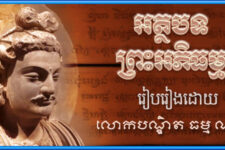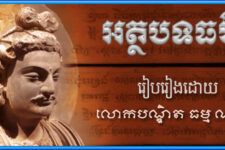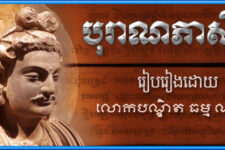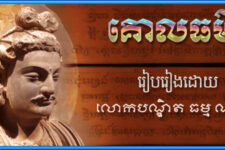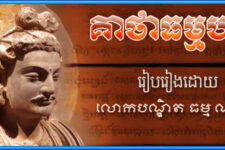THE PALI CANON: What a Buddhist must know(2)
The word of the Buddha: the quintessence of Buddhism
Generally speaking, the term Buddhasāsana “Buddhism” has a very broad semantic coverage, embracing everything ranging from teachings, the Order of monks, organizations, institutions and religious affairs, down to religious places and objects. However, if we delve deeply into its real signification, this term refers to “the Teaching of the Buddha,” as suggested by its literal meaning itself. This indeed constitutes the quintessence of Buddhism, anything other than this being merely its extension or offshoot.
Once this true meaning is grasped, it can be seen that the survival of Buddhism means in effect the existence of the Buddha’s teachings. Should his teachings fade away, no matter how many individuals, religious affairs, and huge religious places and objects there might be, Buddhism cannot be said to exist anymore. Conversely, even if the foregoing external concrete things should be lost, but if the teachings survive, Buddhism can still become known. For this reason, the true preservation of Buddhism all boils down to maintaining the Buddha’s teachings.
To be more specific, the teachings of the Buddha refer to the word of the Buddha or what the Buddha said (Buddhavacana). Essentially, then, to maintain Buddhism is to preserve the word of the Buddha.
By “the word of the Buddha” are meant the Doctrine (Dhamma) and Discipline (Vinaya) set forth and laid down by him. Not long before his Final Nibbāna, the Buddha himself said that not any one monk was to be appointed his successor as Teacher after his passing. Instead, he had it made known to all Buddhists that the Doctrine and Discipline would take his place. A great number of Buddhists even remember the exact wording in Pali, thus:
Yo vo, Ānanda, mayā dhammo ca vinayo ca
desito paññatto. So vo mamaccayena satthā.
“Ānanda! the Doctrine and Discipline I have set forth and laid down for you all shall be your teacher after I am gone.”
On this account, the word of the Buddha is both Buddhism (i.e. what the Buddha taught) and the dwelling place of the Teacher by virtue of maintaining and proclaiming the Doctrine and Discipline on his behalf.
Phra Brahmagunabhorn (P. A. Payutto)
Translated from Thai by Dr. Somseen Chanawangsa.
—————————
ព្រះត្រៃបិដក : គម្ពីរដែលពុទ្ធសាសនិកត្រូវតែដឹង
ព្រះពុទ្ធវចនៈ : ខ្លឹមសារនៃព្រះពុទ្ធសាសនា
និយាយជាទូទៅ ពាក្យថា ព្រះពុទ្ធសាសនា មានន័យទូលំទូលាយណាស់ ឱបក្រសោបគ្របដណ្ដប់ចាប់ពីពាក្យប្រៀនប្រដៅ គណៈសង្ឃ អង្គការ ស្ថាប័ន សាសនកិច្ច រហូតដល់សាសនស្ថាន សាសនវត្ថុគ្រប់យ៉ាងទាំងអស់ ។ ប៉ុន្ដែបើចោះជ្រៅទៅរកអត្ថន័យពិត ព្រះពុទ្ធសាសនាក៏មានន័យត្រង់ៗតាមតួព្យញ្ជនៈរបស់ពាក្យនេះថា “ពាក្យប្រៀនប្រដៅរបស់ព្រះពុទ្ធ” ពាក្យប្រៀនប្រដៅរបស់ព្រះពុទ្ធនេះឯង ជាខ្លួនជាតួពិតរបស់ព្រះពុទ្ធសាសនា អ្វីៗដទៃក្រៅអំពីនេះ គ្រាន់តែជាចំណែកពង្រីកបន្ដ ឬចំណែកដែលដុះចេញអំពីពាក្យប្រៀនប្រដៅនោះ ។
កាលបើចាប់យកអត្ថន័យពិតបានហើយ ក៏នឹងឃើញថា ចីរភាព(គង់វង្ស)នៃព្រះពុទ្ធសាសនាបានដល់ចីរភាពនៃពាក្យប្រៀនប្រដៅរបស់ព្រះពុទ្ធជាម្ចាស់ បើពាក្យប្រៀនប្រដៅ(ព្រះធម៌)របស់ព្រះពុទ្ធជាម្ចាស់រលាយសោះសូន្យទៅហើយ ទោះជាមានបុគ្គល សាសនកិច្ច សាសនស្ថាន និងសាសនវត្ថុធំស្កឹមស្កៃច្រើនប៉ុន្មានក៏ដោយ ក៏មិនអាចចាត់ទុកថាមានព្រះពុទ្ធសាសនាបានឡើយ ។ ផ្ទុយទៅវិញ ថ្វីត្បិតតែវត្ថុដែលជារូបធម៌ខាងក្រៅសាបសូន្យបាត់ទៅ ប៉ុន្ដែបើពាក្យប្រៀនប្រដៅរបស់ព្រះពុទ្ធនៅគង់វង្ស អ្នកផងទាំងឡាយអាចនឹងស្គាល់ព្រះពុទ្ធសាសនាបាន ។ ព្រោះហេតុនេះហើយ ការថែរក្សាព្រះពុទ្ធសាសនាដ៏ត្រឹមត្រូវពិតប្រាកដ គឺការថែរក្សាពាក្យប្រៀនប្រដៅរបស់ព្រះពុទ្ធជាម្ចាស់ ។
ពោលឱ្យកាន់តែចំពោះទៅទៀត ពាក្យប្រៀនប្រដៅរបស់ព្រះពុទ្ធជាម្ចាស់នោះ បានដល់ពាក្យពេចន៍របស់ព្រះពុទ្ធជាម្ចាស់ ឬព្រះតម្រាស់ដែលព្រះអង្គបានត្រាស់ទុក(ពុទ្ធវចនៈ) ដូច្នេះ ការថែរក្សាព្រះពុទ្ធសាសនាដែលជាប្រការសំខាន់ ក៏គឺការថែរក្សាព្រះពុទ្ធវចនៈ ។
ម្យ៉ាងទៀត ព្រះពុទ្ធវចនៈនោះ ជាព្រះតម្រាស់ដែលព្រះពុទ្ធជាម្ចាស់ទ្រង់បានសម្ដែងព្រះធម៌និងបញ្ញត្តព្រះវិន័យទុក ។ មុនពុទ្ធបរិនិព្វានមិនយូរប៉ុន្មាន ព្រះពុទ្ធជាម្ចាស់បានត្រាស់ទុកដោយព្រះអង្គឯងថា មិនទ្រង់តែងតាំងភិក្ខុអង្គណាជាសាស្ដាជំនួសព្រះអង្គ បន្ទាប់ពីព្រះអង្គចូលកាន់បរិនិព្វានកន្លងផុតទៅ ។ ប៉ុន្ដែព្រះអង្គបានត្រាស់ទុកឱ្យពុទ្ធសាសនិកបានជ្រាបថា ព្រះធម្មវិន័យនឹងជាសាស្ដាជំនួសព្រះអង្គ ពុទ្ធសាសនិកចំនួនជាច្រើនបានចាំព្រះពុទ្ធវចនៈជាភាសាបាលីថា
យោ វោ អានន្ទ មយា ធម្មោ ច វិនយោ ច ទេសិតោ បញ្ញត្តោ;
សោ វោ មមច្ចយេន សត្ថា ។
ម្នាលអានន្ទ ធម៌និងវិន័យណា ដែលតថាគតបានសម្ដែងហើយនិងបានបញ្ញត្តទុកហើយ ដល់អ្នកទាំងឡាយ ។ ធម៌និងវិន័យនោះ នឹងជាសាស្ដារបស់អ្នកទាំងឡាយ ដោយកាលកន្លងទៅនៃតថាគត ។
ដោយន័យដូចបានពោលមកនេះ ព្រះពុទ្ធវចនៈ គឺជាព្រះពុទ្ធសាសនា (ពាក្យប្រៀនប្រដៅរបស់ព្រះពុទ្ធជាម្ចាស់) និងទាំងជាទីទ្រទ្រង់សណ្ឋិតនៅនៃព្រះសាស្ដា ដោយទ្រទ្រង់ទុកនិងបានប្រកាសធម៌វិន័យជំនួសព្រះអង្គ ។
———————–
សេចក្ដីប្រែជាខេមរភាសា គ្រាន់តែជាជំនួយសម្រាប់អ្នកដែលអានអង់គ្លេសមិនបានប៉ុណ្ណោះ ។
ដកស្រង់ពីៈ The Pali Canon: What a Buddhist Must Know.
By Ven. Bhikkhu P.A. Payutto
ប្រែសម្រួលអត្ថបទដោយ តាអារាមប៊យ
៣១ មីនា ២០១៨


🔸កំណែចុងក្រោយ Last Updated on February 24, 2025 by Johnny ចន្នី
